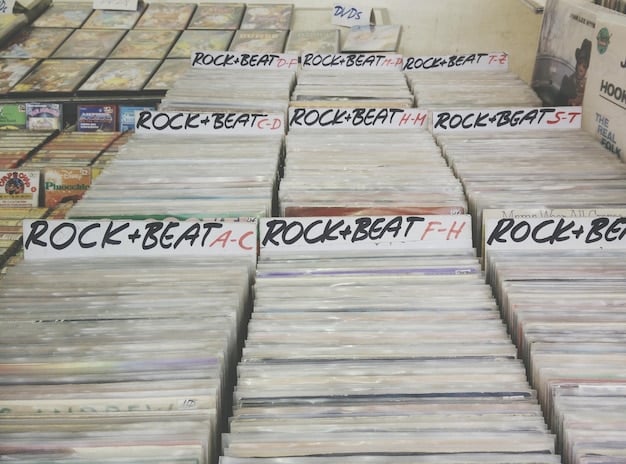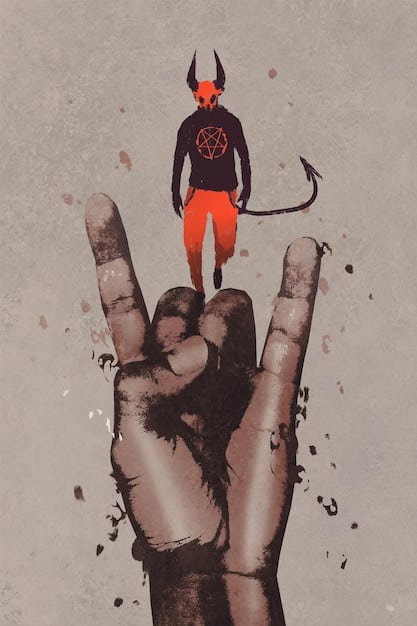NWOBHM Influence: Shaping Modern Metal Subgenres

The New Wave of British Heavy Metal (NWOBHM) dramatically influenced modern metal subgenres by revitalizing heavy metal with raw energy, speed, and aggression, laying the groundwork for thrash, speed, and extreme metal.
The NWOBHM Influence: How the New Wave of British Heavy Metal Shaped Modern Subgenres stands as a pivotal moment in music history. Emerging from the United Kingdom in the late 1970s and early 1980s, it acted as a rebellious response to the fading prominence of established hard rock bands. Blending raw energy, aggressive riffs, and a DIY ethos, NWOBHM bands breathed new life into the metal scene.
The Rise of NWOBHM: A Brief History
The New Wave of British Heavy Metal (NWOBHM) emerged in the late 1970s as a reaction to the perceived stagnation of mainstream rock. This movement injected new energy into the metal scene, setting the stage for numerous subgenres. Let’s delve into the origins and key elements of this influential era.
The Context of Late 1970s Rock
By the late 1970s, many of the original hard rock and heavy metal bands were either experiencing creative lulls or moving towards more commercial sounds. This left a void for a new generation of musicians eager to push the boundaries of heavy music. The economic hardships in the UK at the time also contributed to a sense of urgency and rebellion, which found expression in the raw and energetic sounds of NWOBHM.
Key Characteristics of NWOBHM
NWOBHM bands distinguished themselves with several defining characteristics, influencing subsequent metal subgenres. Key among these was a return to the raw, unpolished sound of early metal, combined with punk’s DIY ethos and aggressive energy.
- Aggressive Riffs and Speed: NWOBHM bands often employed faster tempos, more intricate guitar work, and heavier, more aggressive riffs than their predecessors.
- DIY Ethos: Many bands self-produced their early recordings and relied on independent labels and grassroots promotion.
- Raw Energy: The music was characterized by a raw, unpolished energy that reflected the socio-economic environment.
The rise of NWOBHM was not just a musical phenomenon but also a cultural one. It represented a shift in the landscape of heavy metal, paving the road for the more extreme and diverse subgenres that would emerge in the following decades. Bands such as Iron Maiden, Def Leppard, and Diamond Head became standard-bearers, inspiring countless musicians across the globe.
Speed Metal and Thrash Metal: Direct Descendants
NWOBHM’s influence is most directly visible in the rise of speed metal and thrash metal. The emphasis on speed, aggression, and technicality in these subgenres owes much to the pioneering work of NWOBHM bands. Let’s explore how NWOBHM’s innovations fueled these genres’ development.
The Need for Speed
One of the most significant contributions of NWOBHM was its emphasis on faster tempos and more complex guitar work. This focus on speed and technicality distinguished NWOBHM from earlier heavy metal bands and provided a foundation for the blistering speeds of speed and thrash metal.
Thrash Metal’s Debt to NWOBHM
Thrash metal, with its aggressive riffs and socially conscious lyrics, owes a significant debt to NWOBHM. Consider these bands and elements:
- Metallica: Heavily influenced by Diamond Head and Iron Maiden, Metallica adopted NWOBHM’s aggressive riffs and high-energy performance style.
- Slayer: While developing their unique sound, Slayer incorporated elements of NWOBHM’s raw energy and dark themes.
- Megadeth: Dave Mustaine’s technical and aggressive playing style was influenced by NWOBHM guitarists.
NWOBHM’s influence on speed and thrash metal is undeniable, shaping the sound and style of these genres. The aggressive riffs, high-energy performances, and DIY ethos of NWOBHM bands laid the foundation for the fast-paced, technically proficient, and often politically charged music of speed and thrash metal.

Extreme Metal: Pushing the Boundaries
NWOBHM’s influence extends beyond speed and thrash metal to the broader realm of extreme metal, including death metal, black metal, and other subgenres. The movement’s emphasis on aggression, darkness, and pushing musical boundaries paved the way for these more extreme forms of metal. Let’s look at how NWOBHM contributed to the evolution of extreme metal.
Aggression and Darkness
NWOBHM bands often explored darker themes and more aggressive sounds than their predecessors. This willingness to embrace intensity and darkness was a crucial step towards the more extreme expressions of metal found in genres like death metal and black metal.
Key Elements of Extreme Metal’s NWOBHM Ancestry
Extreme metal genres evolved from the foundations laid by NWOBHM, incorporating its raw energy and aggressive ethos. Several aspects highlight this influence:
- Venom: Often cited as a precursor to black metal, Venom drew heavily from NWOBHM’s aggressive sound and dark imagery.
- Celtic Frost: This Swiss band combined elements of NWOBHM with thrash metal to create a unique and influential sound that paved the way for extreme metal.
- Bathory: Considered one of the founding bands of black metal, Bathory was influenced by NWOBHM’s raw energy and occult themes.
NWOBHM’s impact on extreme metal is profound, setting the stage for genres that push the boundaries of aggression, darkness, and musical experimentation. The movement’s willingness to embrace intensity and explore unconventional themes paved the way for the extreme metal subgenres that continue to evolve today.
Melodic Metal: The Softer Side of NWOBHM Influence
While NWOBHM is often associated with aggression and speed, it also influenced the development of melodic metal subgenres. Bands like Diamond Head and Iron Maiden integrated melody into their music, creating a foundation for genres such as power metal and progressive metal. Let’s examine how NWOBHM contributed to the evolution of melodic metal.
Melody in Metal
NWOBHM bands demonstrated that melody could coexist with the aggression and power of heavy metal. This integration of melody into metal was a crucial step towards the development of melodic metal subgenres. Bands like Iron Maiden became known for their memorable guitar harmonies and soaring vocal melodies.
Power Metal’s Rise
Power metal, with its emphasis on anthemic choruses and fantasy themes, also owes a surprising debt to NWOBHM. These bands and elements highlight that debt:
- Helloween: This German band combined NWOBHM’s energy and aggression with melodic sensibilities to create a distinctive power metal sound.
- Blind Guardian: Heavily influenced by NWOBHM, Blind Guardian incorporated complex arrangements and fantasy themes into their music.
- Stratovarius: This Finnish band fused NWOBHM’s speed and technicality with melodic elements to create a signature power metal sound.
NWOBHM’s contribution to melodic metal is often overlooked, but the movement’s ability to integrate melody into heavy music laid the groundwork for the development of power metal, progressive metal, and other melodic subgenres. The ability to balance aggression and melody remains a defining characteristic of these genres.
Beyond Genres: The Enduring Legacy of NWOBHM
The legacy of NWOBHM extends beyond its immediate influence on specific genres. The movement’s DIY ethos, emphasis on live performance, and commitment to pushing musical boundaries continue to inspire metal musicians today. Let’s look at how NWOBHM’s impact resonates in today’s metal scene.

DIY Ethos and Independent Labels
NWOBHM’s DIY ethos has had a lasting impact on the metal music scene. Many bands continue to embrace independent labels and self-production, following the example set by NWOBHM pioneers. This commitment to independence allows bands to maintain creative control and connect directly with their fans.
Live Performance and Fan Engagement
NWOBHM bands were known for their high-energy live performances and close relationships with their fans. This emphasis on live performance and fan engagement continues to be a hallmark of the metal music scene. Bands regularly tour extensively, connecting with fans on a personal level and creating a sense of community.
Pushing Musical Boundaries
NWOBHM’s willingness to push musical boundaries continues to inspire metal musicians today. Bands experiment with new sounds, incorporate elements from other genres, and challenge conventional notions of what metal can be. This spirit of innovation ensures that metal remains a vibrant and evolving art form.
NWOBHM’s legacy extends far beyond its immediate impact on specific genres. The movement’s DIY ethos, emphasis on live performance, and commitment to pushing musical boundaries continue to influence and inspire metal musicians today.
NWOBHM in the 21st Century
The influence of the New Wave of British Heavy Metal persists into the 21st century, shaping modern metal and its subgenres. NWOBHM’s impact remains relevant, seen in both the music of contemporary bands and how metal is produced and consumed.
Contemporary Musicians and NWOBHM
Today, many metal bands continue to incorporate NWOBHM influences into their music. These bands often cite NWOBHM as a primary source of inspiration, blending classic sounds with modern approaches.
Production and Consumption in the Digital Age
The digital age has revolutionized music production and consumption. NWOBHM’s DIY ethos finds new expression through digital self-releasing and promotional channels. The Internet allows bands to bypass traditional gatekeepers, engaging directly with fans on a global scale.
The digital age provides ample opportunities for both established and emerging talents to embrace the DIY ethic. Social networks, streaming platforms, and online marketplaces provide an array of tools for bands to create, distribute, and market their music independently. Many modern bands are utilizing modern tools inspired by the NWOBHM approach, ensuring the survival of the movement long after its heyday.
| Key Point | Brief Description |
|---|---|
| 🎸 NWOBHM Origins | Reaction to late ’70s rock, emphasizing raw energy and DIY ethics. |
| ⚡ Speed & Thrash | NWOBHM’s speed and aggression fueled the development of speed and thrash metal. |
| 💀 Extreme Metal | NWOBHM paved the way for more extreme genres like death and black metal. |
| 🎶 Melodic Metal | NWOBHM also influenced melodic metal subgenres like power and progressive metal. |
Frequently Asked Questions
▼
The New Wave of British Heavy Metal (NWOBHM) was a movement in the late 1970s and early 1980s that revitalized heavy metal by returning to raw energy and aggressive riffs, influencing many subsequent metal subgenres.
▼
NWOBHM’s emphasis on speed, aggression, and technicality heavily influenced the development of thrash metal bands. Bands like Metallica and Slayer adopted NWOBHM’s raw energy and aggressive riffs.
▼
Key bands of the NWOBHM movement include Iron Maiden, Def Leppard, Diamond Head, Saxon, and Venom. These bands pioneered the sound and style that defined the era.
▼
NWOBHM’s aggression, dark themes, and pushing of musical boundaries paved the way for extreme metal genres like death metal and black metal. Venom, for example, is often seen as a precursor to black metal.
▼
Yes, NWOBHM remains relevant. Contemporary metal bands continue to incorporate NWOBHM influences, and the movement’s DIY ethos still inspires independent artists. Its impact on the genre persists.
Conclusion
In summary, the NWOBHM’s impact is undeniable; its reverberations can be felt throughout the metal landscape, shaping genres and inspiring countless musicians. Its legacy lives on in the bands that carry its torch and in the passionate fans who keep its spirit alive.





